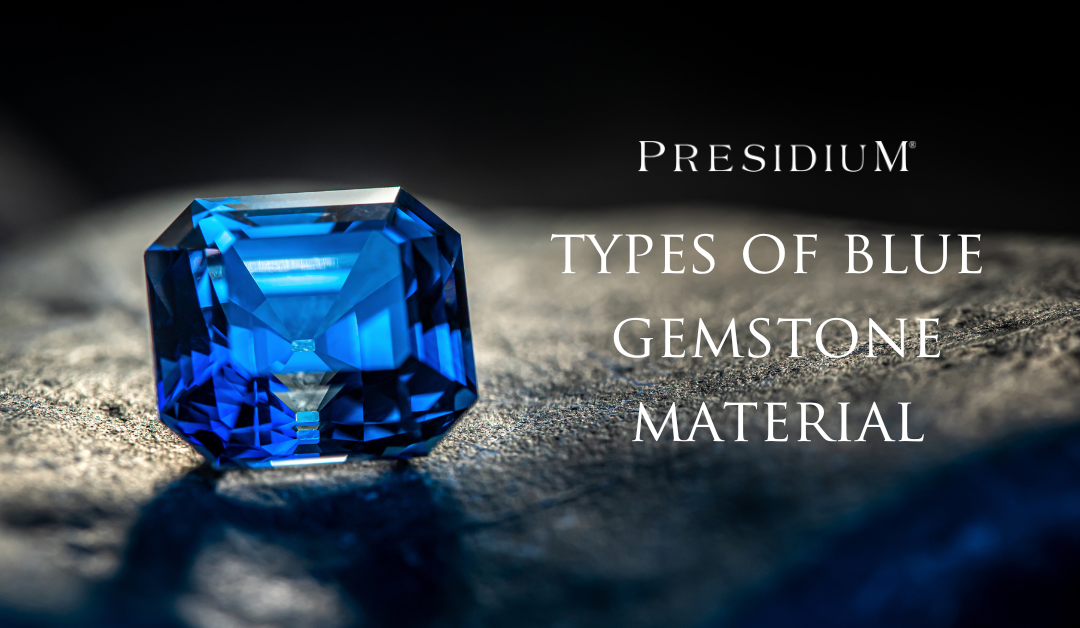
The color blue is one of the rarest colours found in nature. The world of gemstones showcases some of its most beautiful jewels in this shade. From light blue to deep blue, from greenish blue to purplish blue. Blue gemstones have always been nothing short of fascinating for gemstone collectors. Amongst them are some of the rarest blue gems we can find on earth, such as cobalt blue spinel, to something more common like aquamarine. Nevertheless, each blue gem material has its own unique characteristics and properties.
Here are some of them:
A surprising fact to many is that sapphires and rubies belong to the same corundum gem family. They’re siblings! They both share prominent roles in gemstone history and industry. Sapphires are made of aluminium oxide (Al2O3), and they are colourless when pure. They are known for their intense blue caused by traces of iron and titanium in its atomic structure. Sapphires come in different colours too and this is caused by different transitional trace elements, i.e. small amounts of chromium - pink; vanadium - purple; green - iron (Fe2+); and yellow - iron (Fe3+).
Blue sapphires are one of the highest prominence in our history. Used on many occasions to symbolise royalty and wealth, it is a stone for kings and queens. It is no wonder why sapphire had that kind of stature because very few gemstones are able to compete with its deep intense blue colour and transparency. In particular, sapphires found in the Kashmir region are famed for their vivid blue hue plus soft velvety appearance which is caused by extra fine rutile needles that scatter passing light without compromising their clarity.
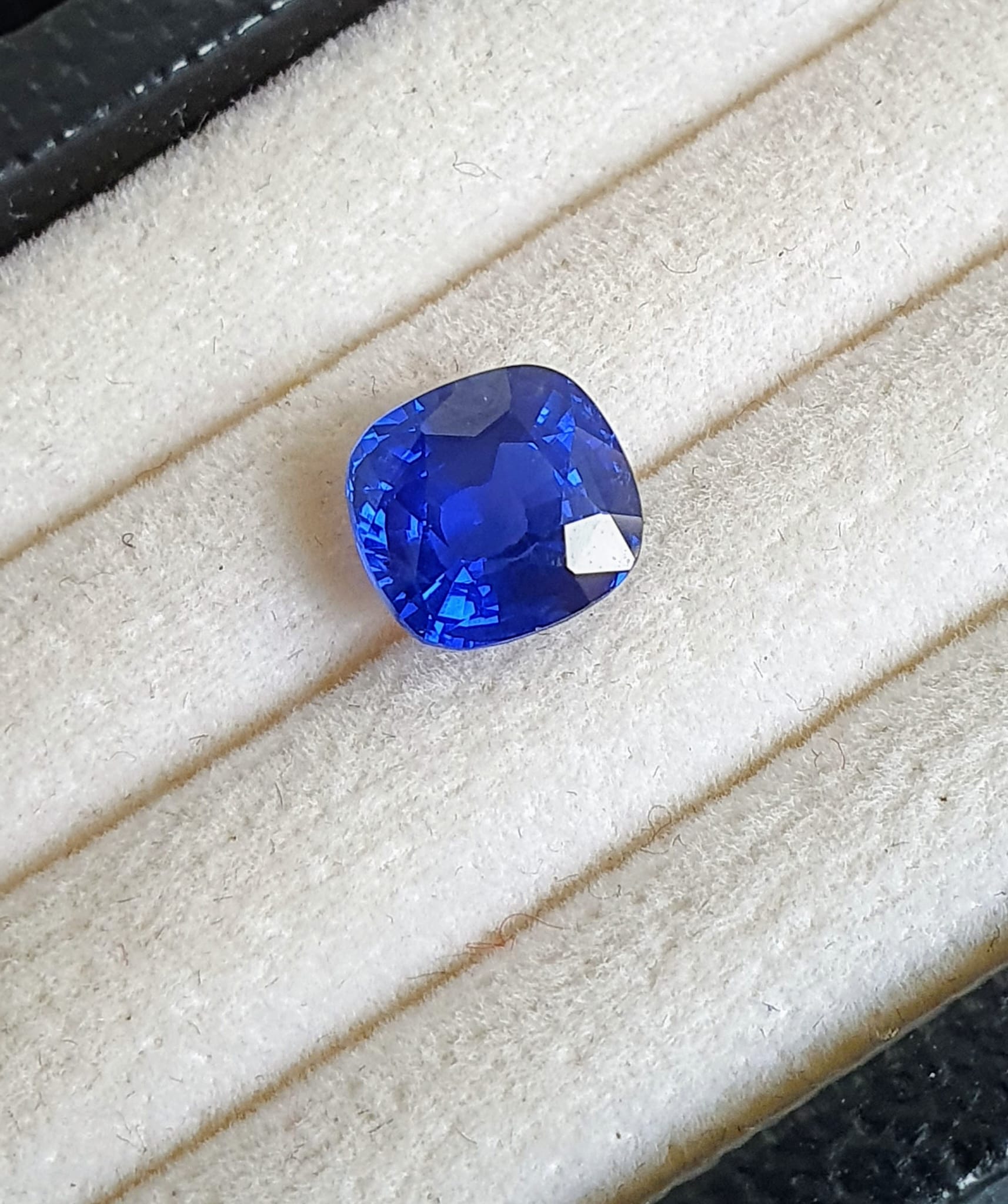 |
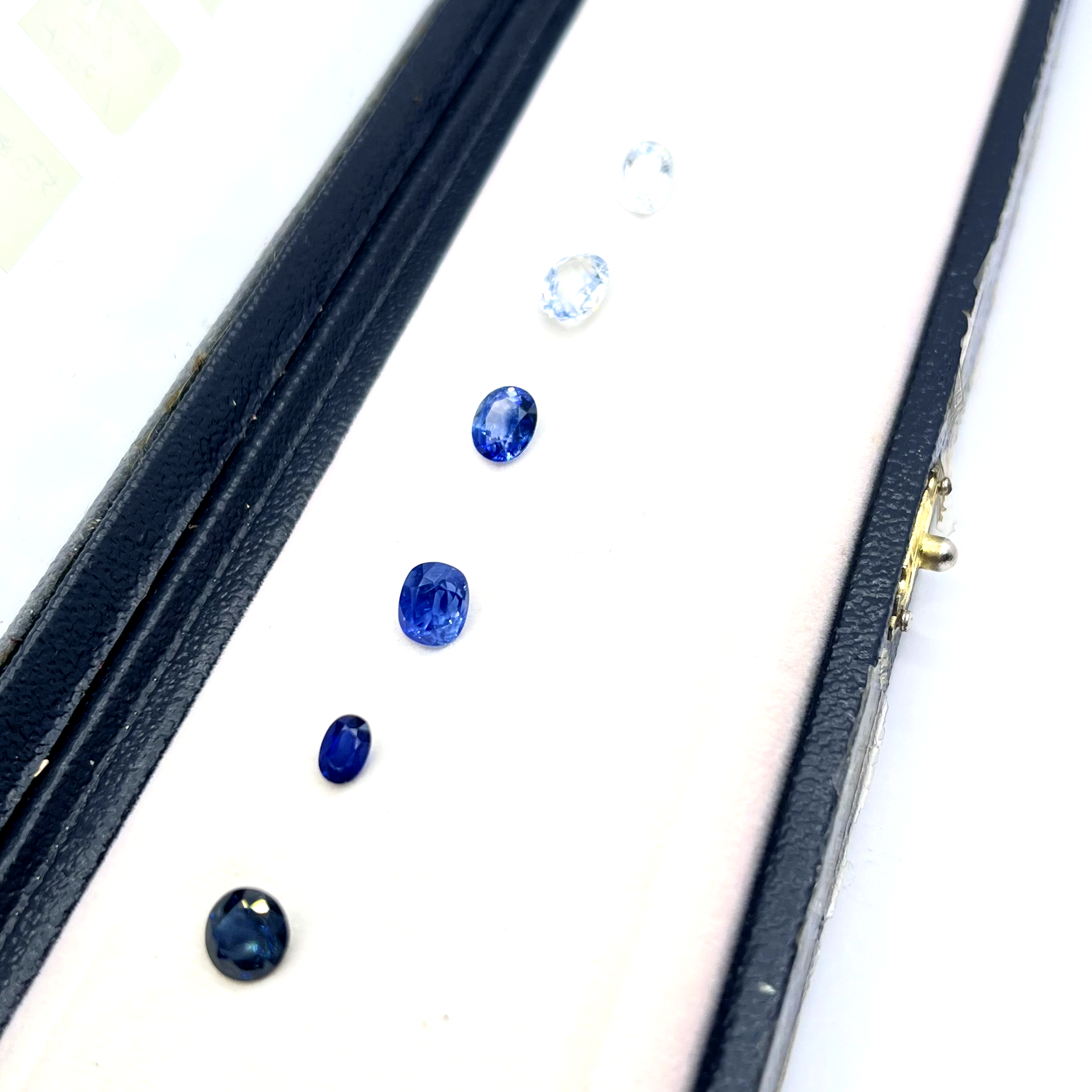 |
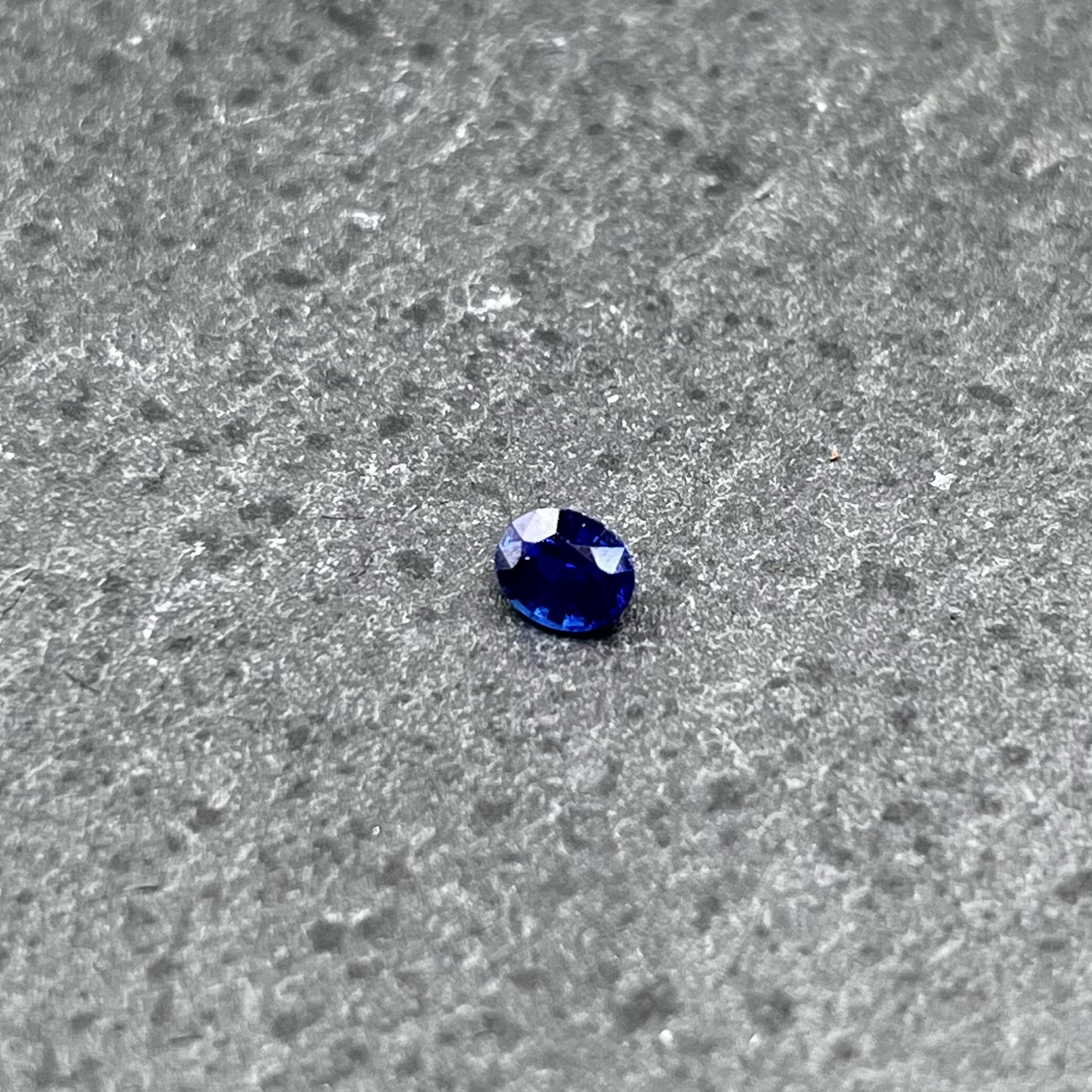 |
|
This is an example of a heat treated sapphire that resulted in a beautiful blue colour which is very rare to find in nature. |
A range of blues in sapphire. From the lightest blue on top to the darkest blue at the bottom. Range of size of this set of blue sapphires is between 0.55ct and 1.71ct. |
A 0.50ct cornflower blue sapphire. |
Sapphires are highly sought-after in the jewellery industry. Extremely durable gemstone at a Mohs hardness of 9 with no cleavage (structural weakness) makes it a perfect gem for everyday wear. Furthermore, colour is sapphire’s strength. Royal Blue, sapphire’s top colour grade, is a uniform vivid blue colouration with no hue modifier (i.e. no secondary colour) when viewed from the table . It is this attribute that contributed to the highest price ever paid for a blue sapphire. In spite of that, its blue comes in all tones and shades of blue from pale to dark, a more reason to be popular.
Here are some places where sapphires are most commonly found: Sri Lanka, Thailand, Myanmar, Kashmir (India), Madagascar, Australia, Montana (USA), Shandong (China), Pakistan, India, Ethiopia, Vietnam, Tanzania, Cambodia, Brazil, Kenya, Malawi, Nigeria, Rwanda, Zimbabwe, Finland (some star sapphires).
 |
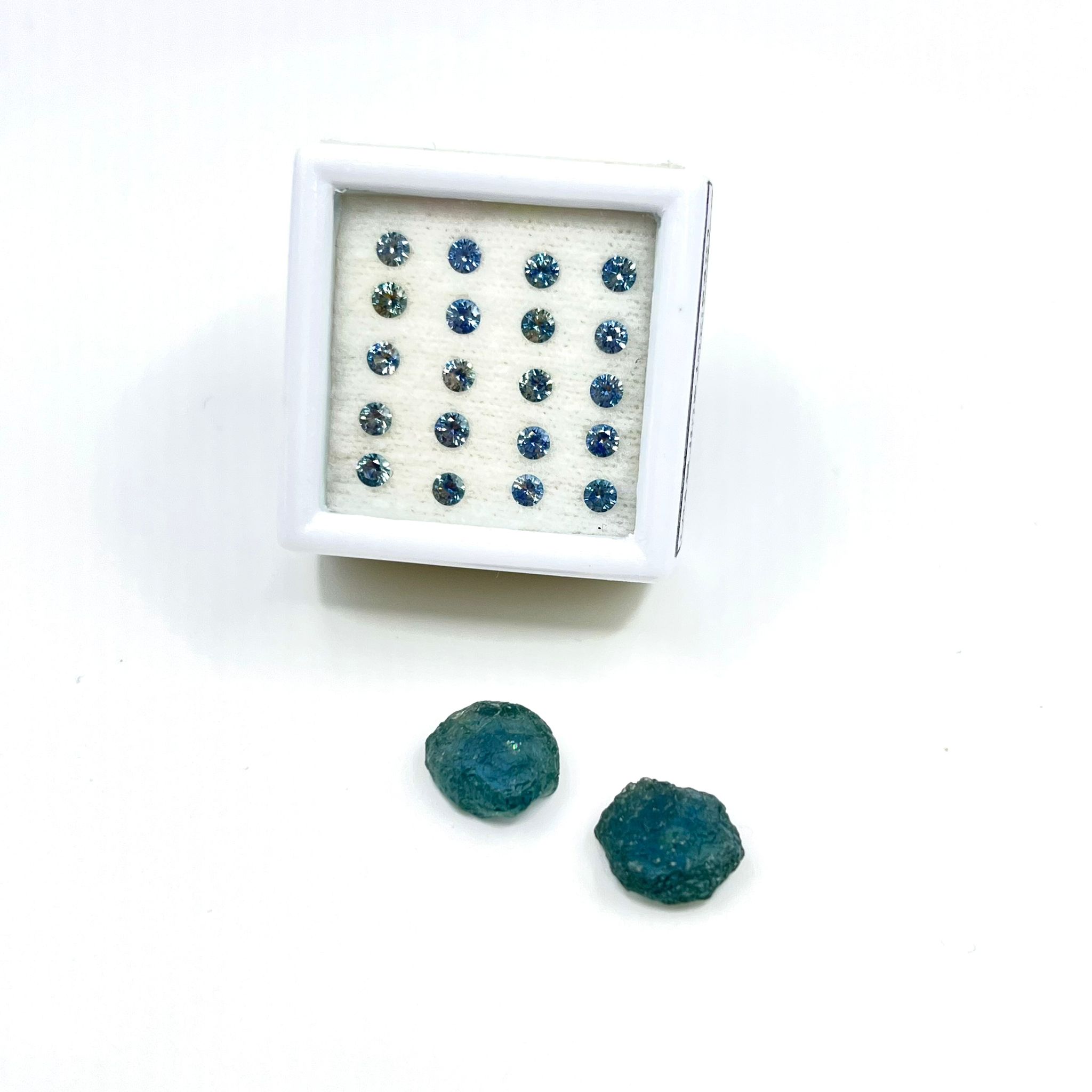 |
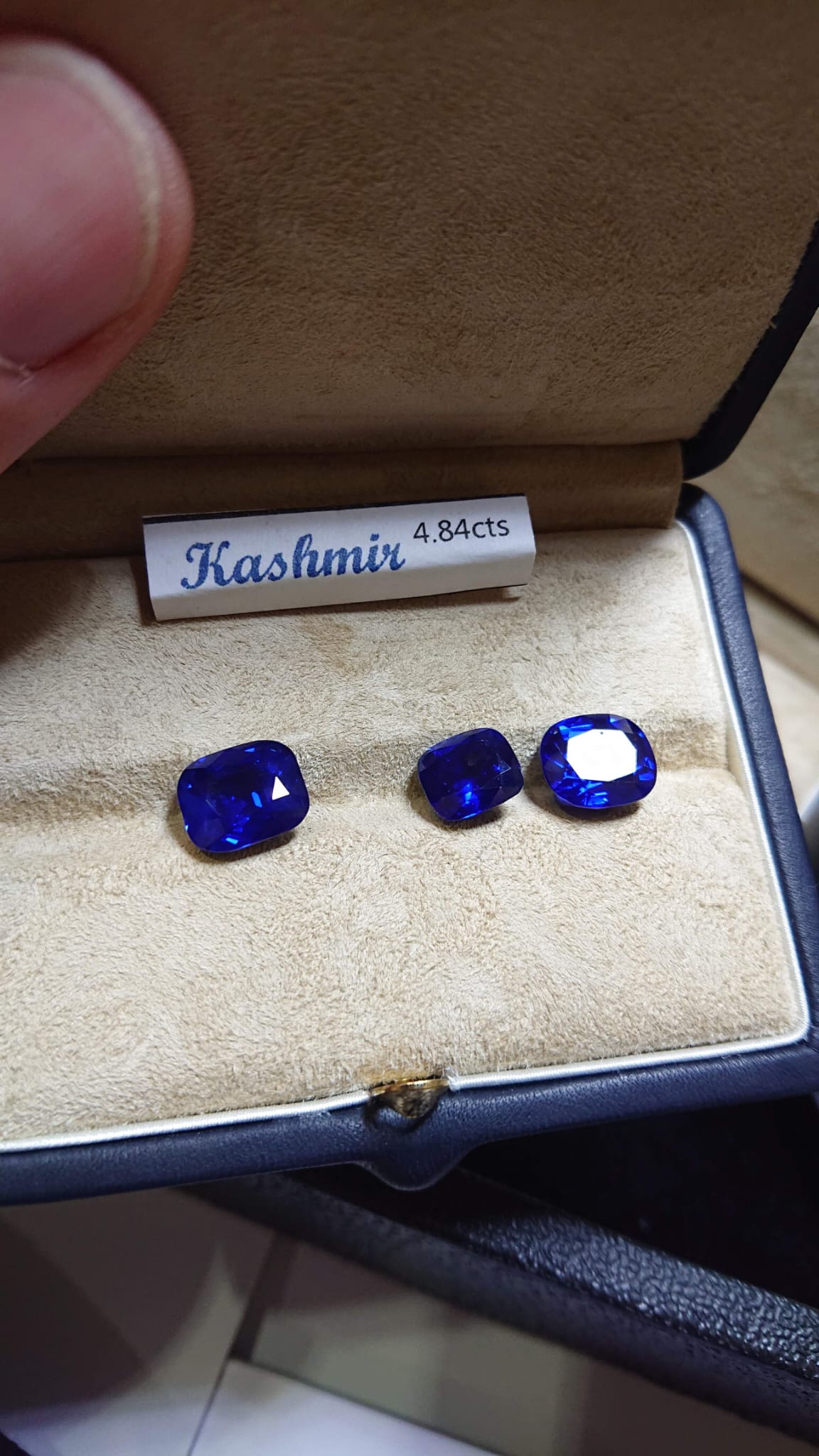 |
|
Back row (left to right): Corundum from China, Madagascar, Myanmar. Front row (left to right): Corundum from Sri Lanka, Tanzania. Different localities may produce sapphire crystals of slightly different quality and size. |
Here are some sapphires from Montana, USA, rough and polished. |
3 pieces of Kashmir sapphires with a total weight of 4.84 carats. |
A sky blue variety of the beryl mineral species, aquamarines are a lesser saturated blue gem that needs no introduction. Thought to be a gem created by the sea and carries the ability to calm oceans, it is now a popular gem choice for customised and sometimes high-end jewellery.
What causes aquamarine’s attractive colour is mainly due to the trace element of iron. Like all gems, the more trace elements, the more vivid the colour it gets. For aquamarine, its blue saturation largely lingers around the lower range of the colour tone, which contributes to its sky blue colour. Despite that, most natural aquamarines occur with a slight tint of green, due to different oxidation states of iron within the crystal lattice of the crystal. Therefore, to create pure blue hue, the majority of aquamarines in the market are exposed to heat treatment with the sole purpose of removing the green tint. With that it allows them to show the sky blue it is known for. Heat treatment on aquamarine is generally accepted in the trade even without disclosure.
Although aquamarine has a lower colour saturation compared to sapphire, it does have a wide tone range from pale blue to Santa Maria blue - a deeply saturated blue colour. Generally blessed with superior clarity, clear to the eye specimens are quite easily attainable.
Summary of common localities of aquamarine: Brazil, Santa Maria (USA), Myanmar, Sri Lanka, Pakistan, Afghanistan, Queensland (Australia), China, India, Kenya, Madagascar, Mozambique, Namibia, Nigeria, Zambia, Zimbabwe.
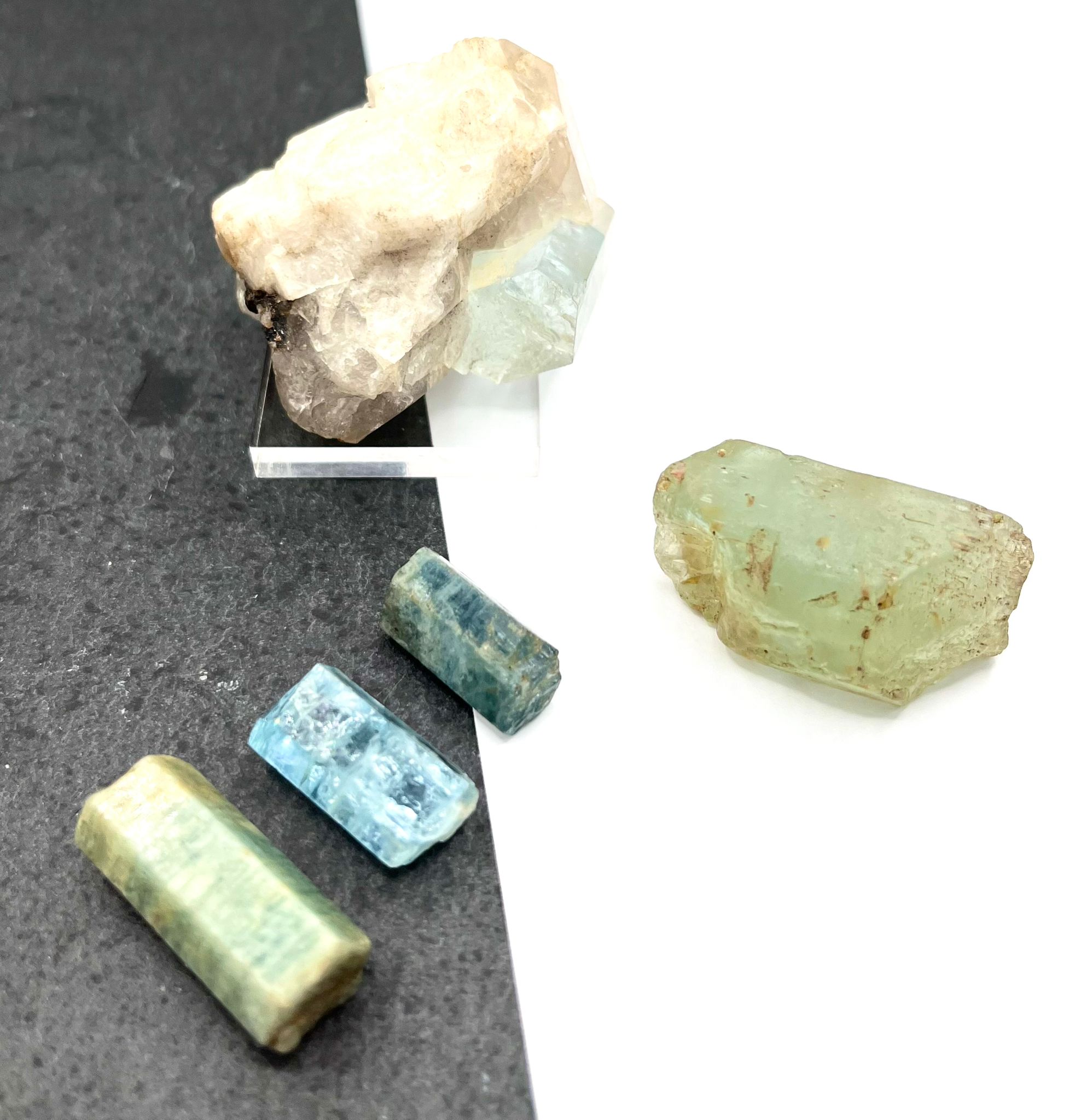 |
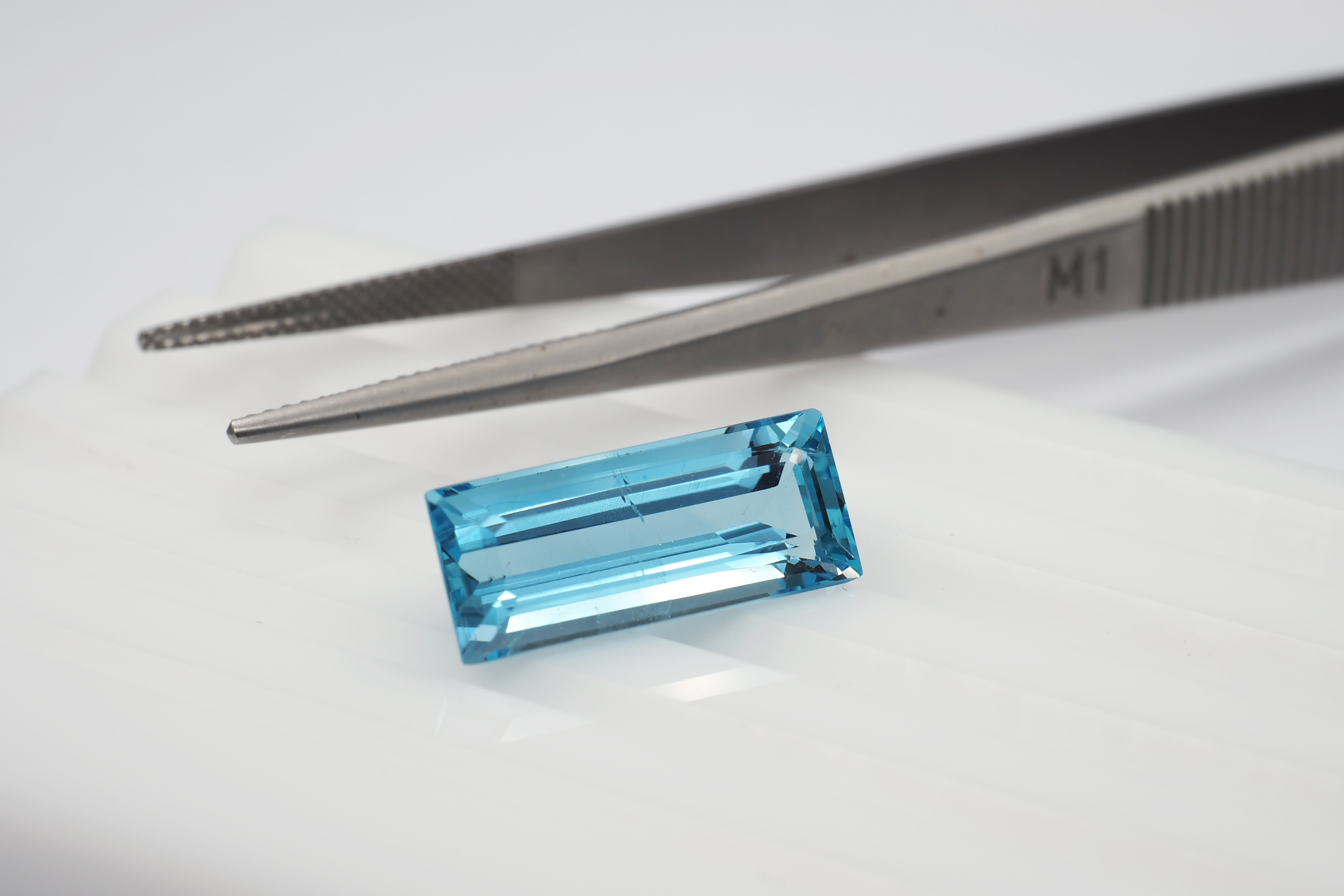 |
, Far East Gems Jewellery.jpg) |
.jpeg) |
|
Here are some rough aquamarines from various parts of the world, Brazil, Pakistan, Myanmar. |
A 6.19ct baguette cut aquamarine getting ready to be set into a piece of jewellery. Heated aquamarines tend to show a ‘purer’ blue colour as compared to the unheated ones, which tend to show a shade of green with the blue. |
An approximately 20 carat size aquamarine set as a pendant. Due to its clarity and size, aquamarine are often used as the main gem in a large piece of jewellery. Clean and large sized aquamarines are sometimes hard to come by. |
A 20 carat pear-shaped Madagascan aquamarine with a Santa Maria colour. Notice the deep blue colour as compared to the aquamarine in the previous two pictures. |
Tourmalines are known to be available in a wide variety of colours. There are two blue varieties namely Indicolite, and the rare Paraiba.
Indicolite is more common.. Its colour usually leans towards a darker tone of blue, mainly due to the colour agent of iron which also causes it to be dark. On the bright side, indicolite has superior clarity.
Paraiba on the other hand, is the rarest variety of the tourmaline group. Originally discovered in the late 1980s in Brazil, it was soon also uncovered in Nigeria and Mozambique in very limited quantities. Its colour is unlike any other. Coloured by traces of copper or manganese comes a uniquely neon blue or green that is unforgettable. This amazing hue can easily compensate for the eye-visible inclusions which can be common in paraibas. A good quality cut that highlights its natural brilliance and scintillation improves its value exponentially. In the paraiba market, heat-treatment is very common. It helps turn those non-neon-copper/manganese-bearing tourmalines into paraibas, this increases their supply in the market. Currently, identifying heat treated paraibas proves to be more difficult than expected, if just by using standard equipment. Thus, it would be best to assume the paraiba is heated unless stated otherwise.
Summary of common localities of tourmalines: Minas Gerais, Pariba (Brazil), Sri Lanka, Myanmar, Mozambique, Vietnam, California, Maine (USA), Madagascar, India, Pakistan, Nigeria, Namibia, France, Tanzania, Italy
 |
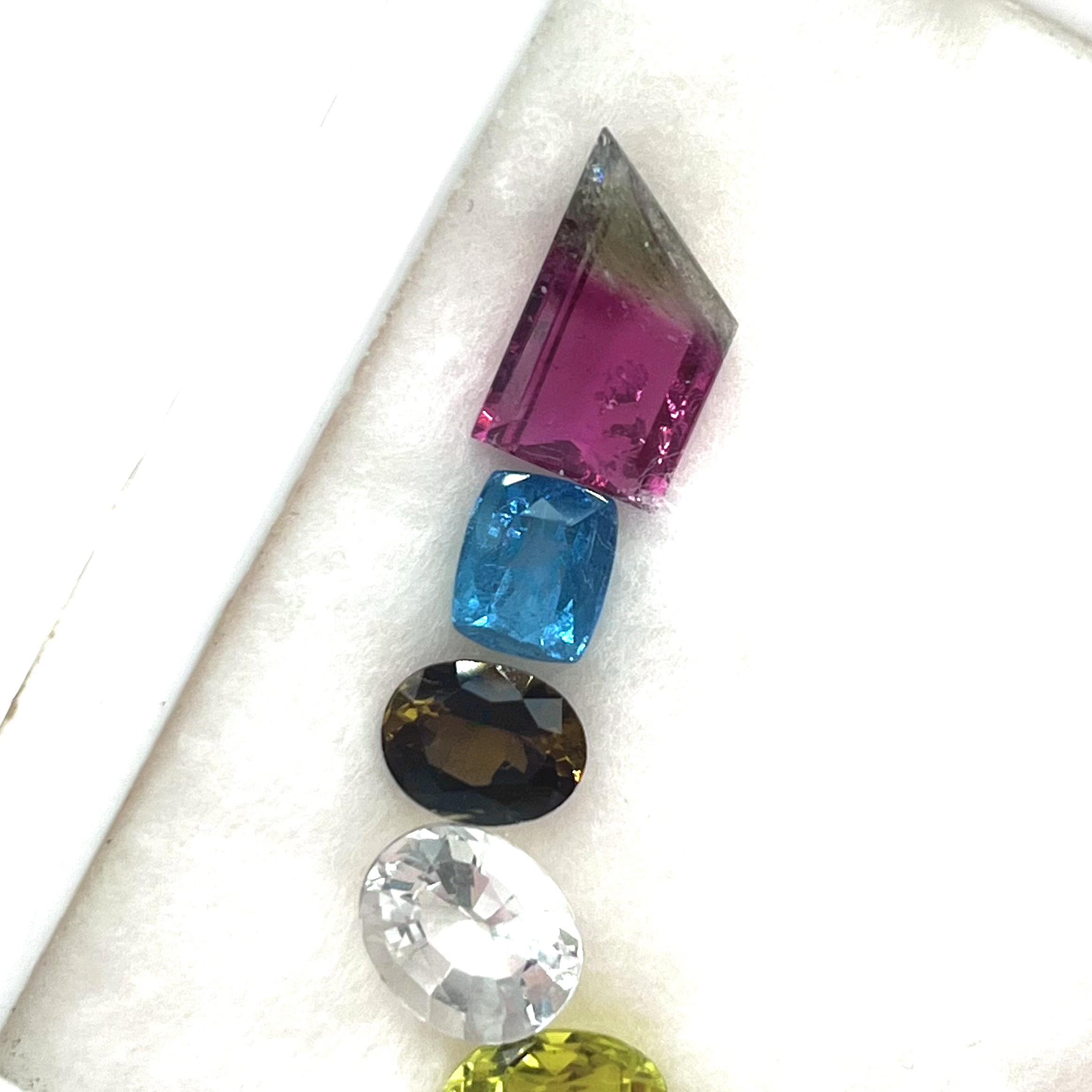 |
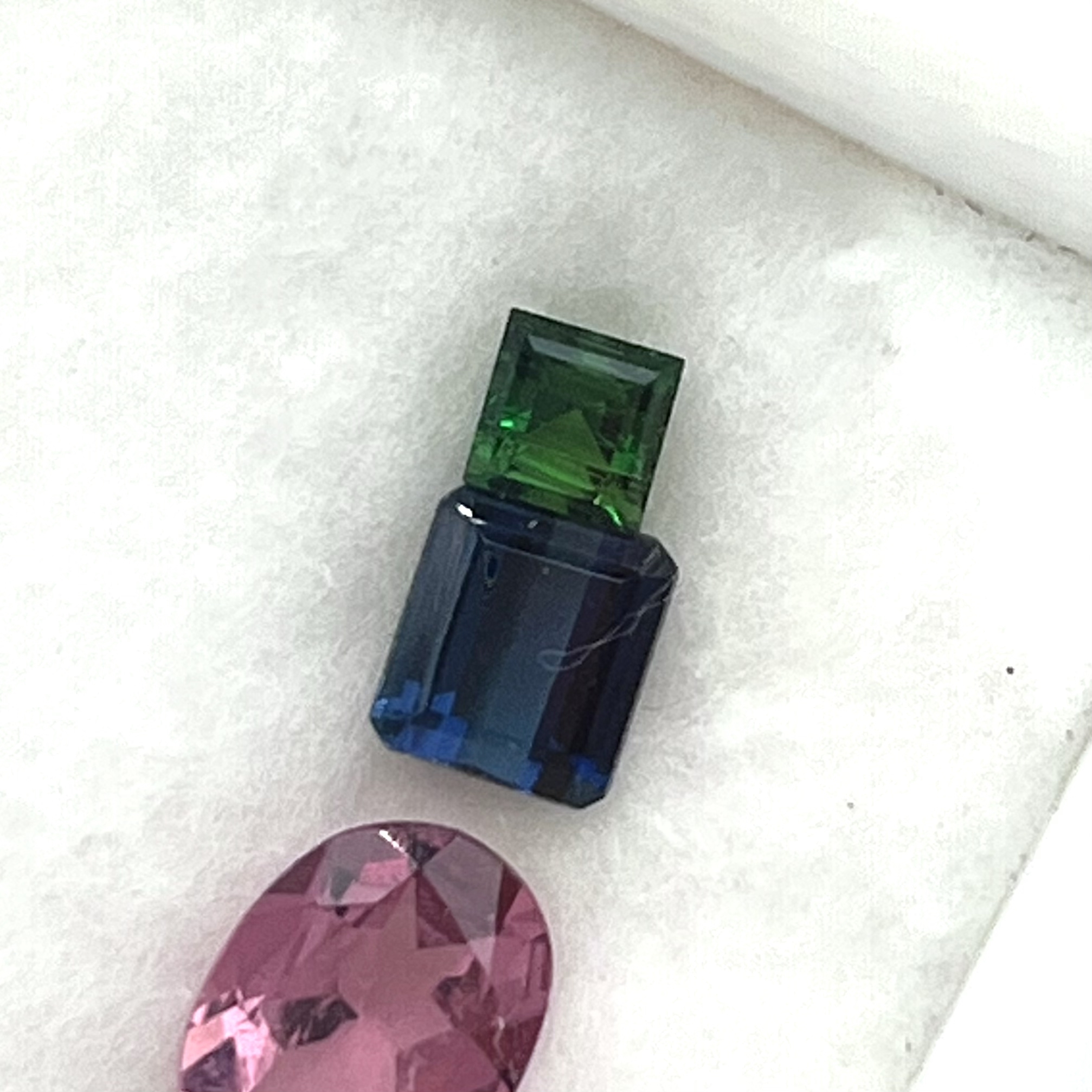 |
|
A box of tourmalines with its variety of different colours. |
Unheated paraiba tourmaline in the box. | Indicolite |
 |
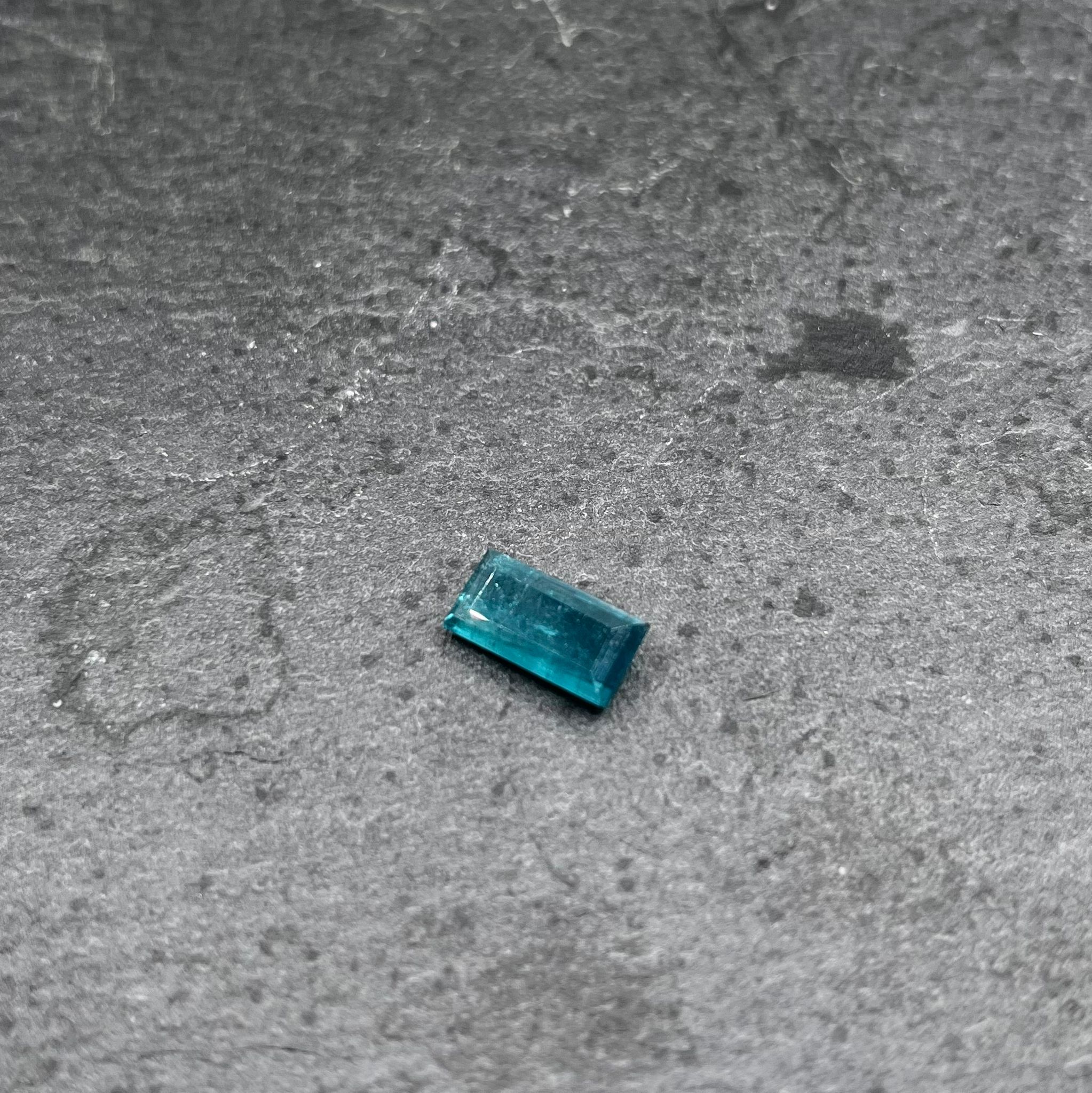 |
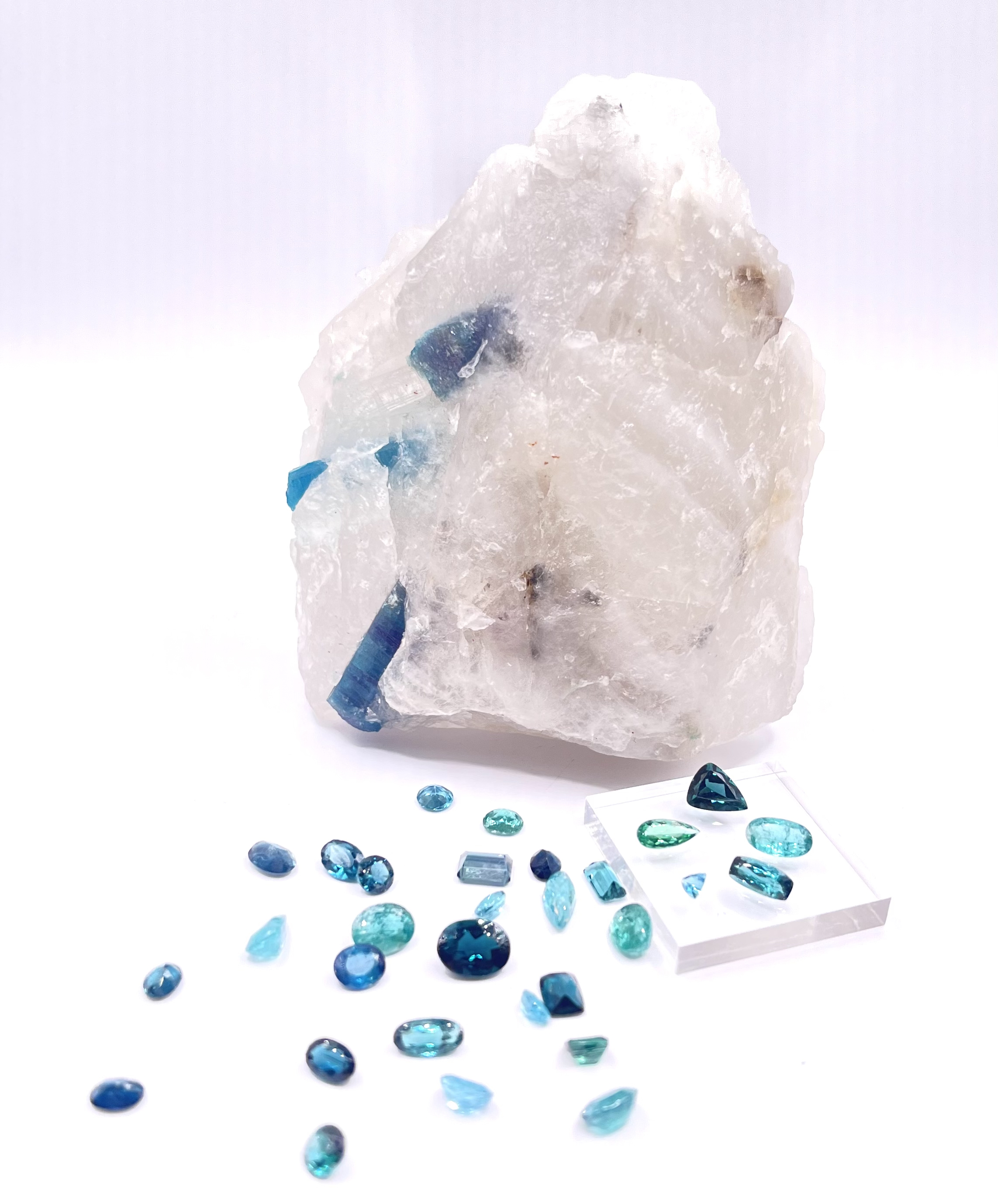 |
| A 1.49ct baguette cut indicolite | A 3.06ct indicolite that has a tinge of green that almost makes it look like a paraiba tourmaline |
A paraiba crystal specimen in matrix and one lot of faceted unheated paraiba tourmalines from Brazil. |
Considered a modern gem, this blue gem burst into the market by storm after it was discovered in 1967, with the help of Tiffany & Co. As blue as a sapphire, tanzanite is found in only one place in the world, the Merelani Hills in Tanzania. On top of its vivid colour, tanzanite possesses excellent clarity which helps boost its popularity in the jewellery industry. Consumers are attracted by its unique colouration and choose to overlook that it has a lower hardness than most popular gemstones at 6.5 and a perfect cleavage in one direction.
What makes tanzanite unique is its eye-visible trichroism, making it shift into three different colours - blue, purple, and brown/red, when viewed from different axes of the gem. It proves to be an extra challenge for lapidarists due to this optical property as they have to properly orient the gem during cutting so as to showcase a specific colour. The demand for blue gemstones remains strong and as such, the choice of colour to highlight while cutting tends to slant towards blue.
Tanzanite is a gemstone commonly subjected to heating. Heating primarily removes unfavourable brown/red colour in a tanzanite gem, permanently converting the stone to a dichroic gem, while increasing its hue saturation in the process. It allows consumers to enjoy the vivid blue or purple without having any interference by the brown/red.
Summary of locality: Tanzania (Africa)
 |
|
A custom-designed 1.66carat pear-shaped tanzanite set with diamonds and pink sapphires in an 18k unplated white gold ring. |
A magnesium aluminium oxide, this gem is fast gaining momentum in its value. Hard, refractive, and colourful, spinel can be utilised in jewellery for its relatively clean clarity, and also collected as a mineral specimen for its symmetrical octahedral crystal habit.
Blue spinel has a lesser exposure in the market when compared to red spinel, which is considered to be an alternative to ruby. The blue spinel can be substituted for a blue sapphire. It is coloured by the element of iron in most cases creating deep dark tones of blue.
Another example of spinel’s fast track to stardom, is the discovery of the “cornflower” type blue spinel. In the early 2000s, it was unearthed in Luc Yen, a rural district in Yen Bai, Vietnam. For so long, it is the only source for cobalt-coloured spinel, and that propelled this bright blue gem into one of the rarest gemstones. Moreover, gem-quality cobalt specimens are ridiculously scarce, so rare even a fairly clean 0.50ct is considered a novelty.
Summary of common localities of spinel: Sri Lanka, Myanmar, Vietnam, Africa, Cambodia, Brazil, Madagascar, Nepal, Nigeria, Tadzhikistan, Tanzania, Thailand, New Jersey (USA), Australia.
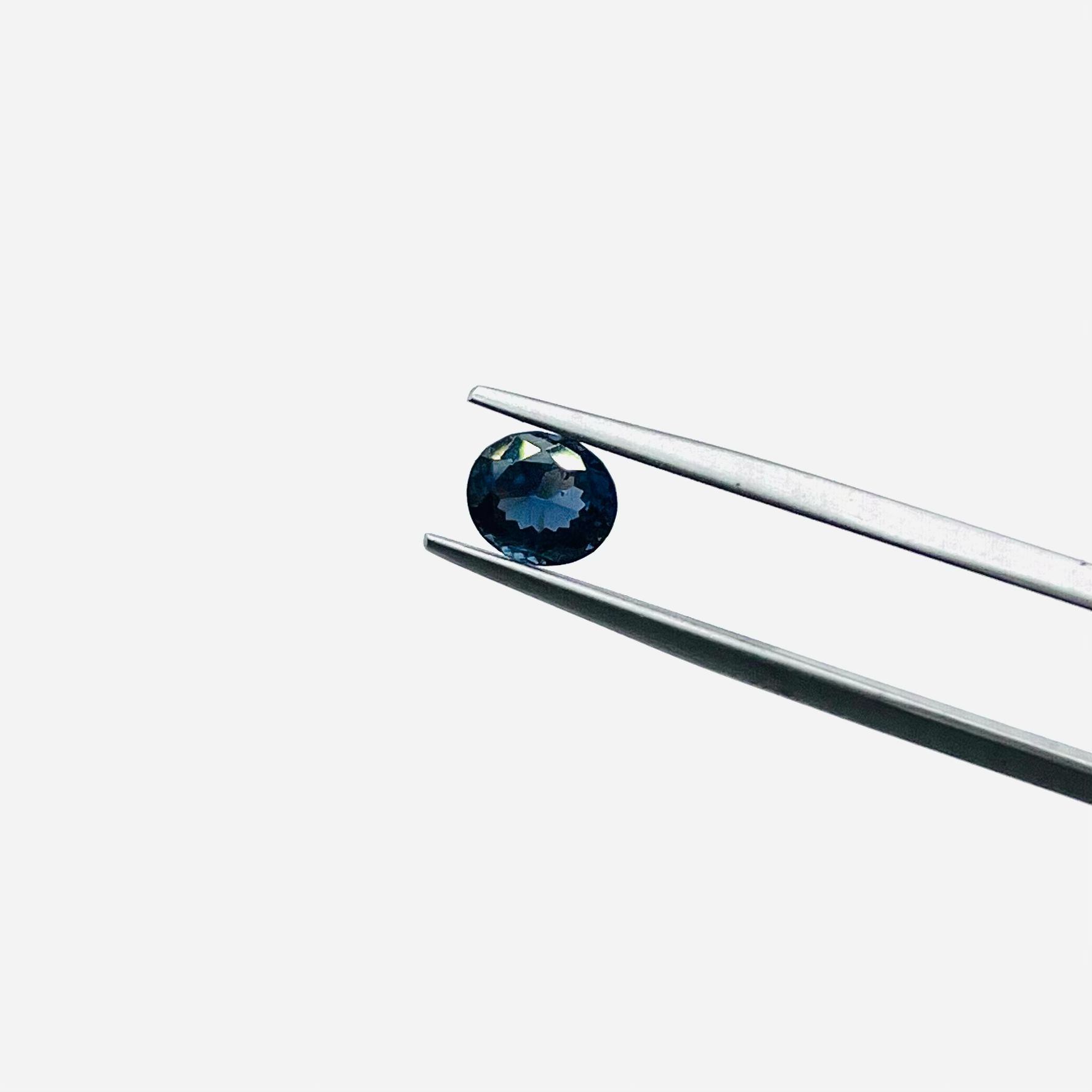 |
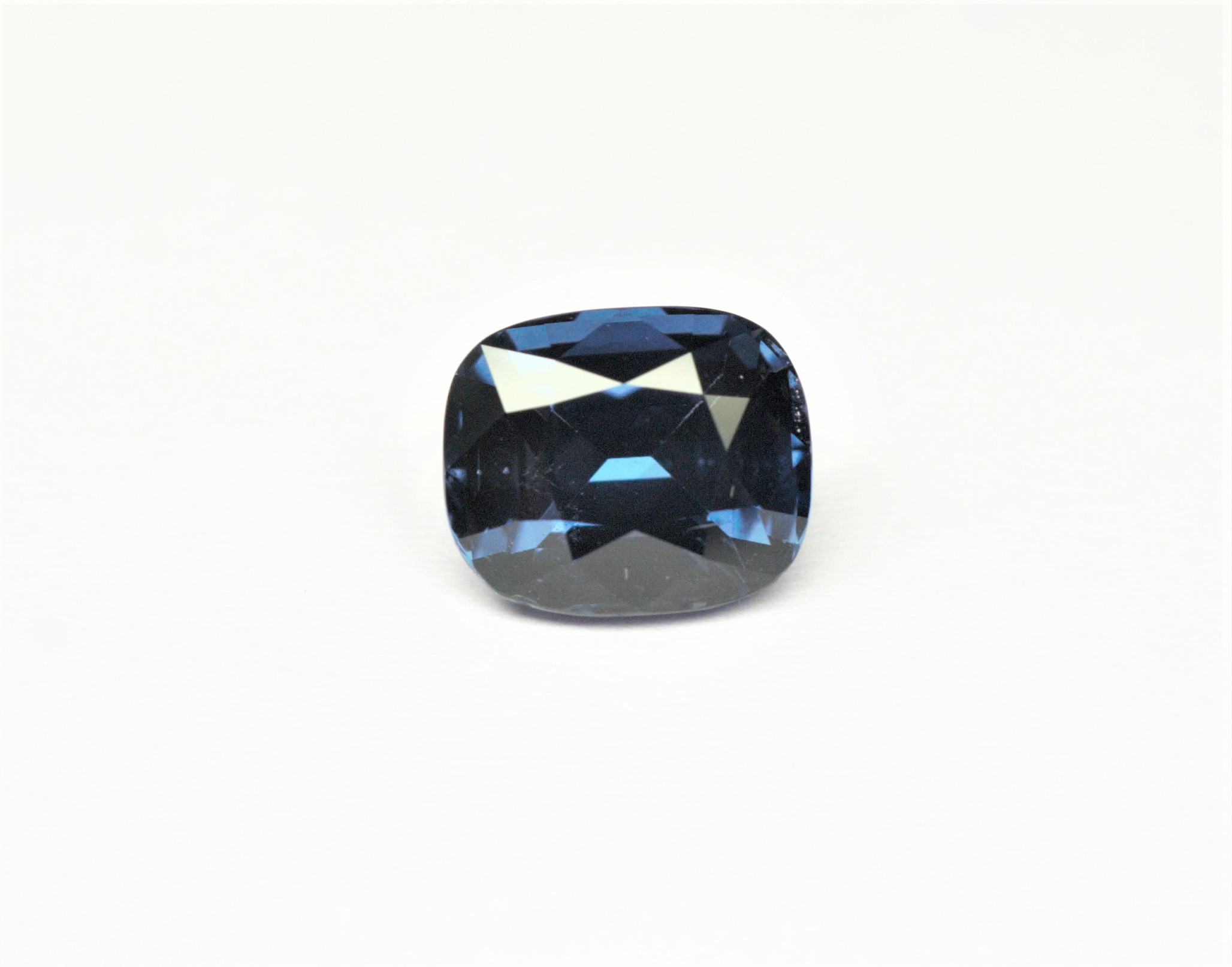 |
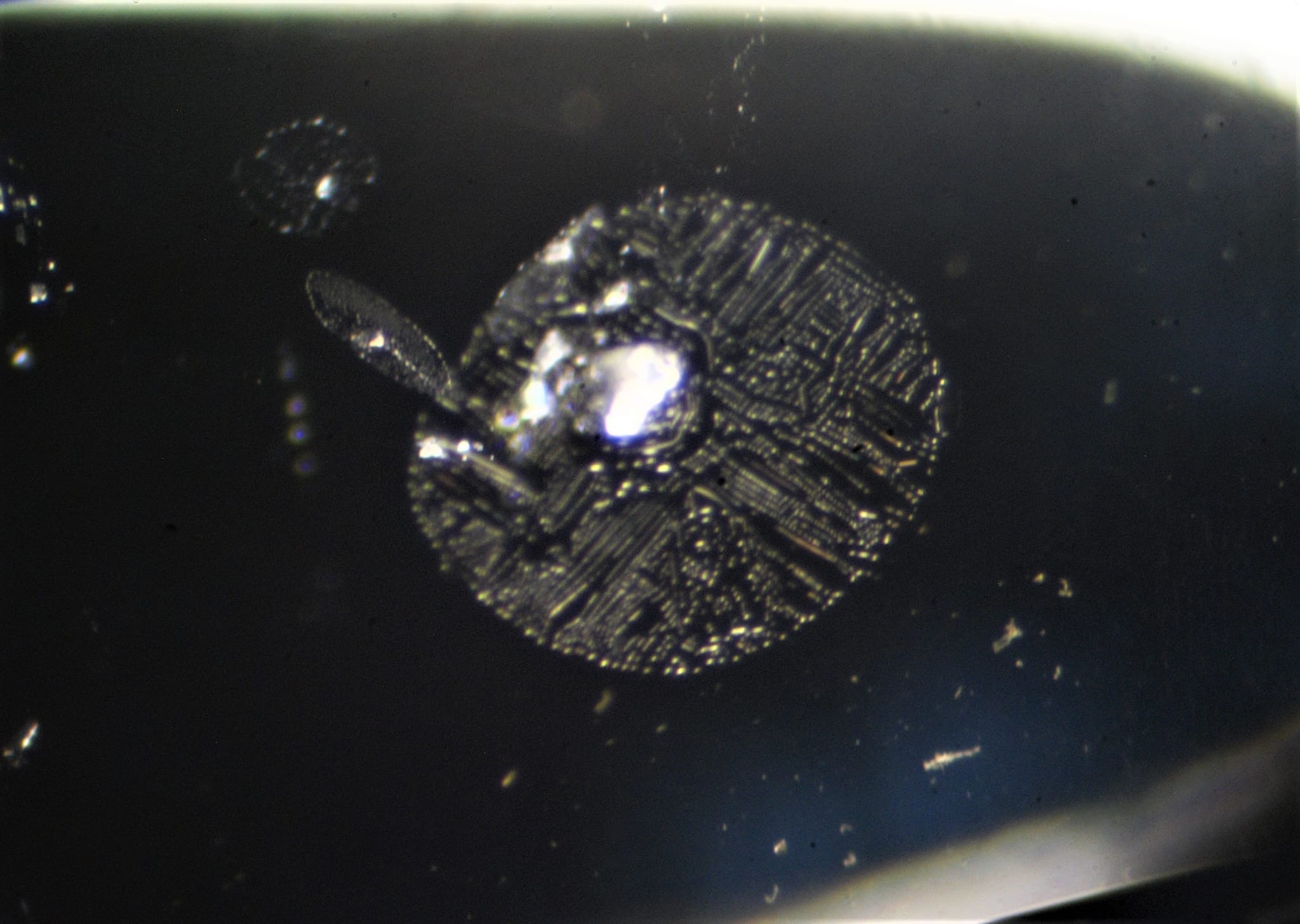 |
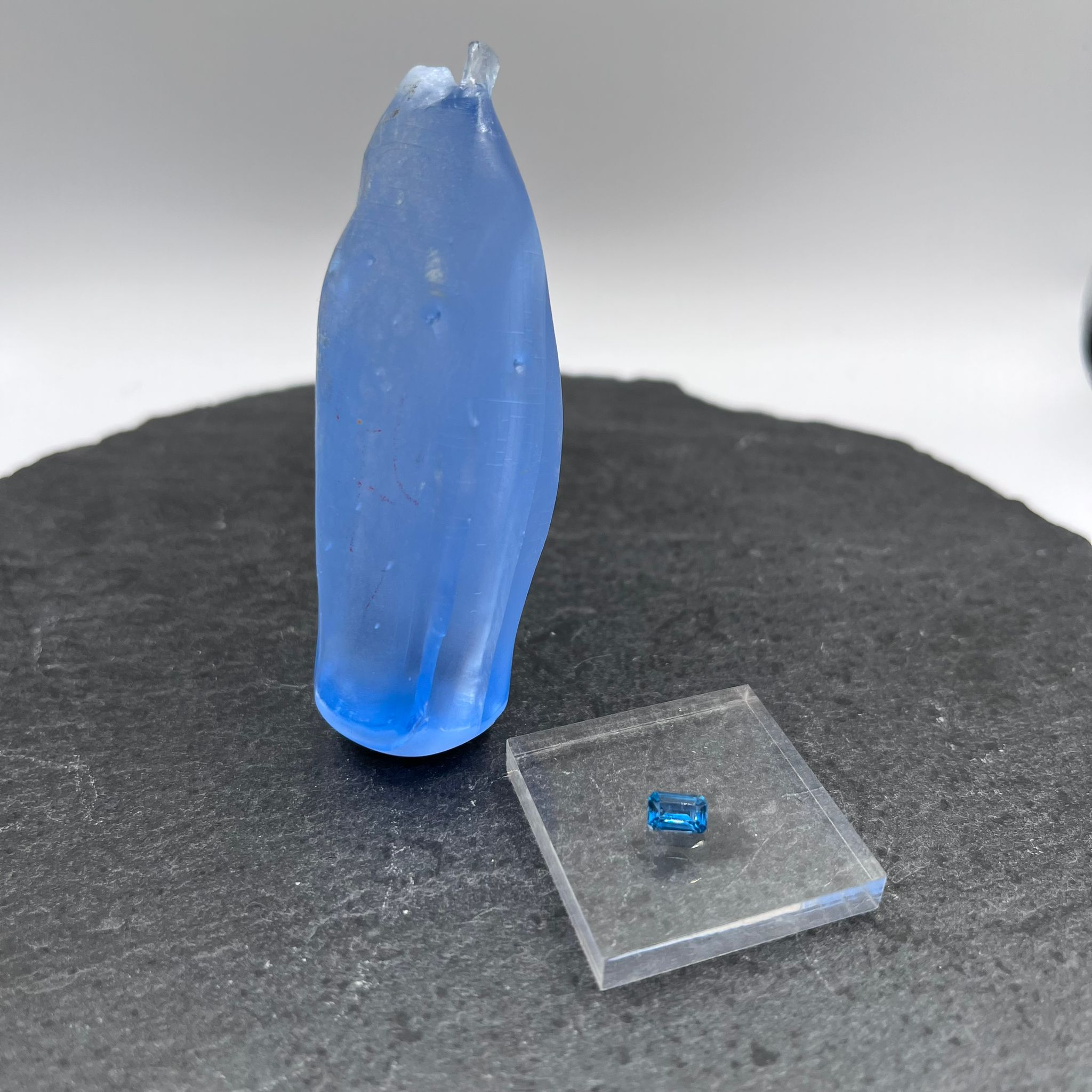 |
| A 1.32 carat blue spinel. This blue spinel may come in a range of greyish blue to greenish blue and purplish blue. The blue colour is caused mainly by iron | Shown here is a 3.01carat gahnospinel. This is a species of gem that is between spinel and gahnite (also known as zinc spinel) in composition, coloured by iron | This photo taken under the microscope at about 20x magnification shows a natural fingerprint inclusion in the gahnospinel | Vernueil Flame Fusion synthetic blue spinel, rough and 0.72ct faceted synthetic blue spinel coloured by cobalt |
Topaz is a silicate mineral best known for its physical properties and colour. Being the hardest silicate mineral at the Mohs hardness of 8, albeit having a perfect basal cleavage, it is a gem suitable for everyday usage while complemented by its large range of natural colours.
Topaz is typically found in a chemically pure and colourless state. Colourless topaz is often used as a diamond simulant although it has a lower refractive index that inhibits brilliance. But when trace elements come into the mix, it produces some of the rarest topaz colour ever known. Colours like orange, red, pink, purple, and blue are rare and hence, highly valuable and collectable.
Among its rare colours, blue turns out to be the most popular in the market. Natural blue topaz is incredibly rare, and mostly pale in colour. Therefore to supply the market's demand, treating of topaz is necessary. One effective way to turn colourless, yellow, and even brown topaz to blue is through irradiation followed by annealing for colour stability. The condition of this process can be variable, which results in different blue tones and vividness. These different blue shades are better known as “Swiss Blue” for a medium-toned blue and “London Blue” for a dark-toned blue. Due to this widely used treatment, blue topaz are commercially available and low prices make them favourable for costume jewellery.
Summary of common localities of topaz: Brazil, Myanmar, Sri Lanka, China, Afghanistan, Japan, Madagascar, Mexico, Namibia, Nigeria, Pakistan, Russia, Australia
 |
 |
|
Two pieces of polished natural blue topaz. |
Left: 3.78ct London Blue Topaz; Right: 4.55ct Swiss Blue Topaz; Both topazes have been irradiated and annealed. |
Zircon is often mislabelled as lab-grown in the form of cubic zirconia. It is, however, a natural silicate mineral that also acts as the main ore for the element of zirconium, even providing for its unrelated “cousin” cubic zirconia to be manufactured.
Natural blue zircon do exist, but extraordinarily rare. Similar case as the topaz, in order to obtain a mass quantity of blue zircons, treatment is necessary in the form of heating from colourless or brown zircon. This has led them to be widely available which resulted in its value to diminish. Heating of gemstones is a traditional and often accepted practice. It is hard to state with certainty if a zircon has been heat treated. Therefore, it is always safe to assume that a blue zircon gemstone has been heat treated.
Summary of common localities of zircon: Cambodia, Sri Lanka, Myanmar, Thailand, Brazil, Korea, Madagascar, Mozambique, Nigeria, Tanzania, Vietnam.
 |
 |
|
An intense blue colour round brilliant cut zircon. It is known that if irradiated blue zircons are heated, its colour reverts to a brown colour. However, this process is reversible by exposing the gem under ultraviolet light. |
Five pieces of blue zircons, ranging from 0.45ct to 1.55ct. |
To define these two apart, agate is a “banded chalcedony” and chalcedony has a more homogeneous appearance. One thing in common is that both must be translucent, in between transparent and opaque. A type of cryptocrystalline quartz whose crystal structure cannot be observed with an optical microscope. These materials have densely packed atomic structures and they can be very tough, hence easily polished without the worry of breakage.
Both occur in various colours, but rarely vivid and deep in saturation. Even so, its pale blue can be really attractive. Concentrically banded agates usually form alternating banding of blue and white, better known in the trade as “Blue Lace Agate”. However, due to its porous nature, dyeing of agates is extremely common. Artificial colours can easily seep into a shallow depth of the agate, giving a vivid, usually blue, colour. Chalcedony on the other hand, does not have those concentric bandings of an agate and often has white, grey, or greyish-blue appearance.
Summary of common localities of agate: Brazil, India, Madagascar, Malawi, Namibia, Zimbabwe, Sri Lanka, Uruguay, California (USA)
 |
 |
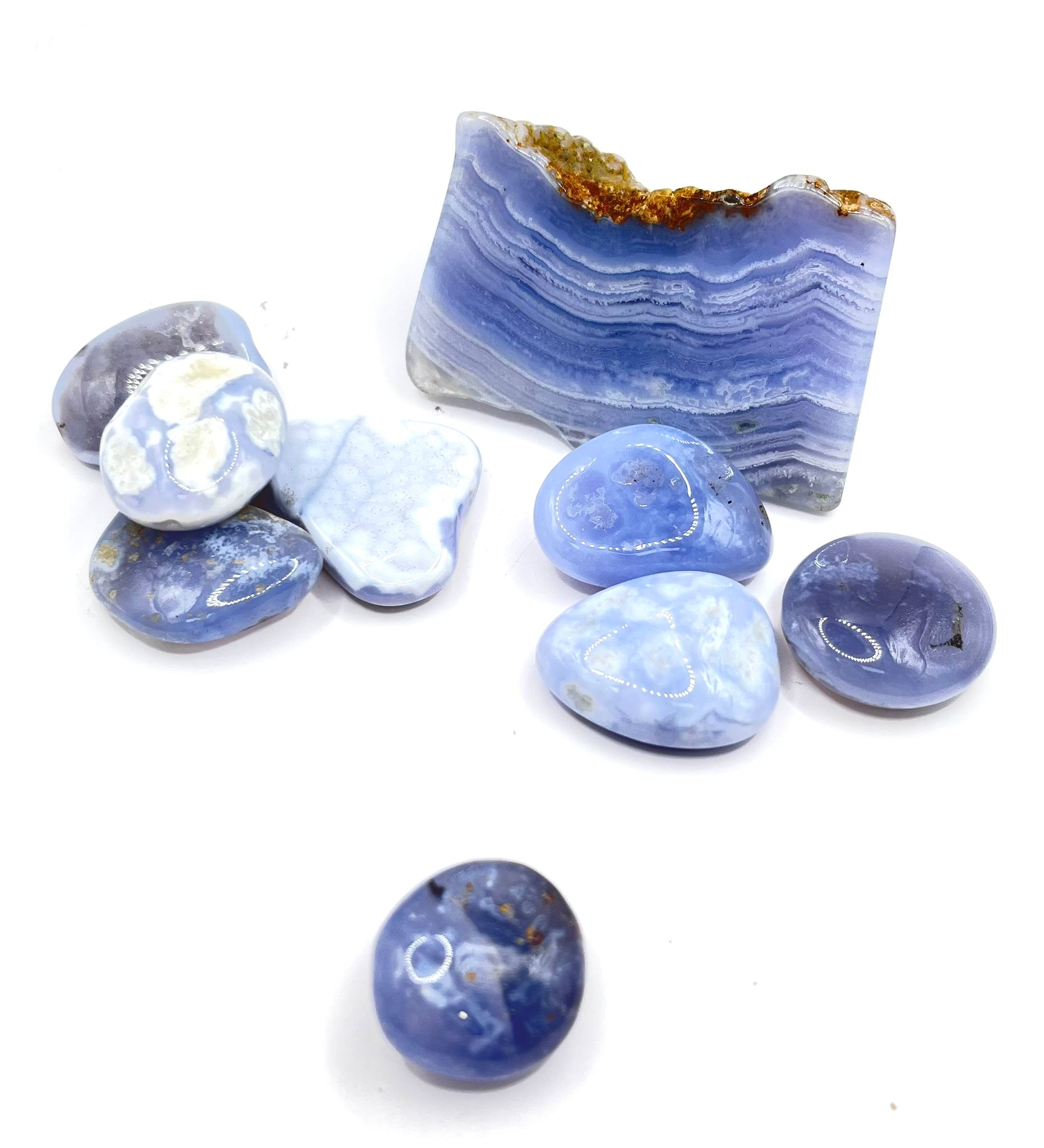 |
|
A large piece of blue dyed coloured agate. Notice that the colour is very intense like having paint. |
Back: Blue Lace agate; Front: Tumbled chalcedony from Turkey | |
Lapis lazuli is one of the most ancient materials ever used as gemstone. Dated back to the BCE times, it was carved, polished, cut, even grinded into pigments. To date, lapis remains a popular ornamental gem for carving and beadings for its midnight blue colour. Some of the best lapis are still extracted high up in the mountains of Afghanistan.
Technically, lapis lazuli is an opaque rock - a composite of two to three minerals into one, they are lazurite, calcite, and pyrite. Lazurite, responsible for its deep blue colour, with streaks of white/grey calcite and speckles of silver/golden pyrite. Lapis with a uniform blue colouration throughout and gold speckles of pyrite with minimal calcites tends to achieve the highest value.
Did you know Vincent van Gogh’s The Starry Night blue sky was painted with ultramarine - a pigment originally made by grinding lapis lazuli into powder.
Summary of common localities of lapis lazuli: Afghanistan, Myanmar, Pakistan, Russia, Chile, Angola, Canada, California (USA), Colorado.
 |
 |
 |
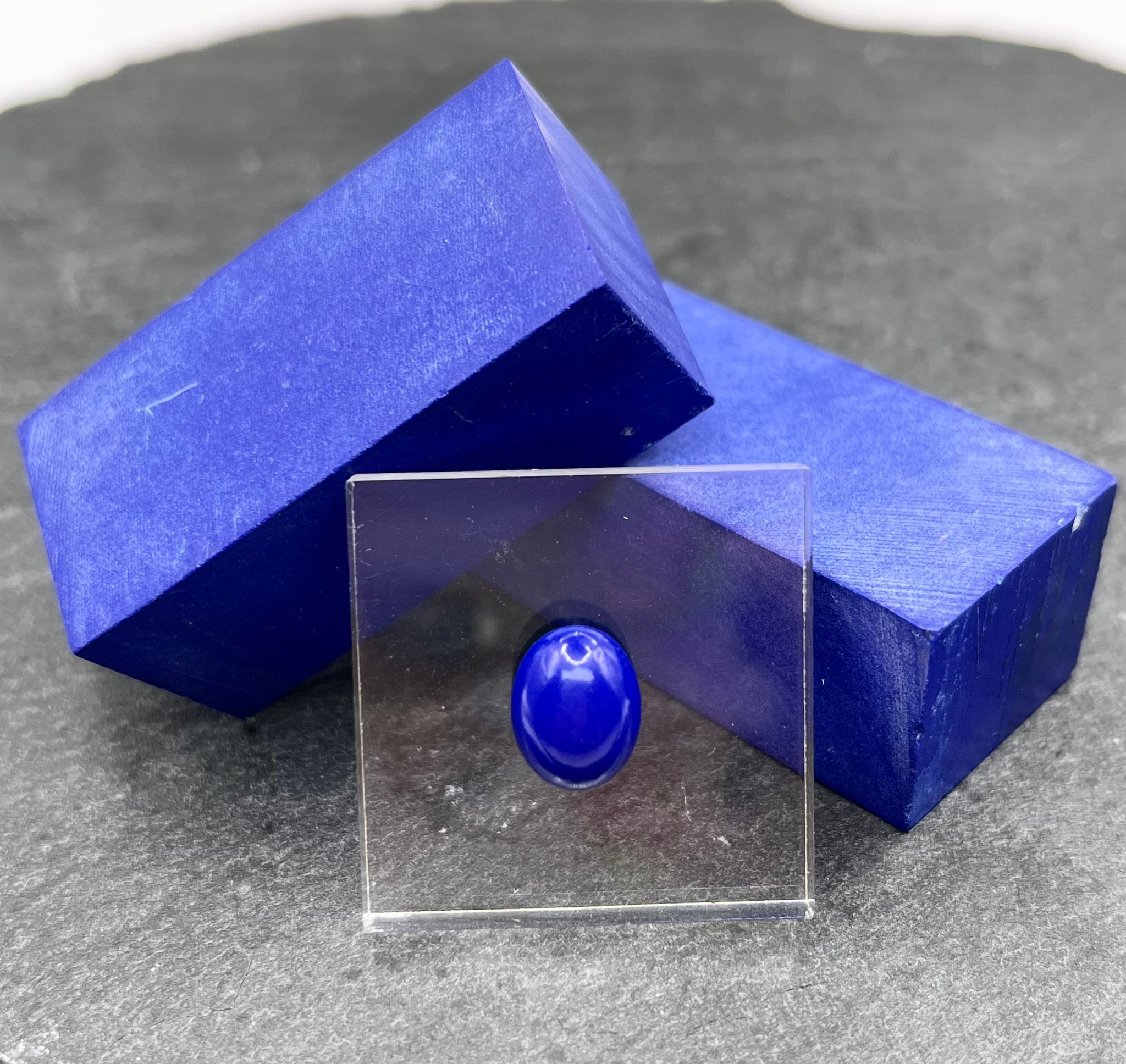 |
|
A Lapis Lazuli carving from Afghanistan. The white specks are calcite, golden specks are pyrite and blue is lazurite. |
Three pieces of lapis lazuli, origin unknown. Left to right: 7.22ct, 4.78ct, 6.94ct. Notice the differences in quality. |
Rough lazurite in marble matrix with one lot of polished gem quality lazurite. |
The two blocks at the back are Gilson 'synthetic' lapis lazuli. It is something like blue coloured ceramic. This material does not contain any lazurite as part of its composition. Front: Cabochon cut Gilson 'synthetic' lapis lazuli. These kind of materials may be seen in accessory jewellery. |
Unlike most transparent blue gemstones, turquoise’s opacity prohibits it to be polished into a sparkly gem. Nonetheless, natural blue gem materials are scarce and therefore the colour of turquoise stood out. It attracted users for its saturated blue as seen in Iranian specimens, or a sky blue saturation seen in Chilean or Arizona specimens. Its cooling greenish-blue colour even earn a colour named after itself, hex code: #30D5C8.
Turquoise has gotten its colour from the element of copper, which is also an essential chemical for its formation. Not very often that a turquoise turns out to be pure blue hue, in which case it may look greenish or sometimes green-dominant. The good grade turquoise typically appears homogeneous colouration, but some top grade turquoise contains webbing-like structure from its host rock. Intricately spreaded out the stone like a black web, these types certainly rare.
Summary of common localities of turquoise: Turkey, China, Iran, Chile, Afghanistan, Argentina, Australia, Brazil, Israel, Mexico, Tanzania, New Mexico (Arizona, USA).
.jpg) |
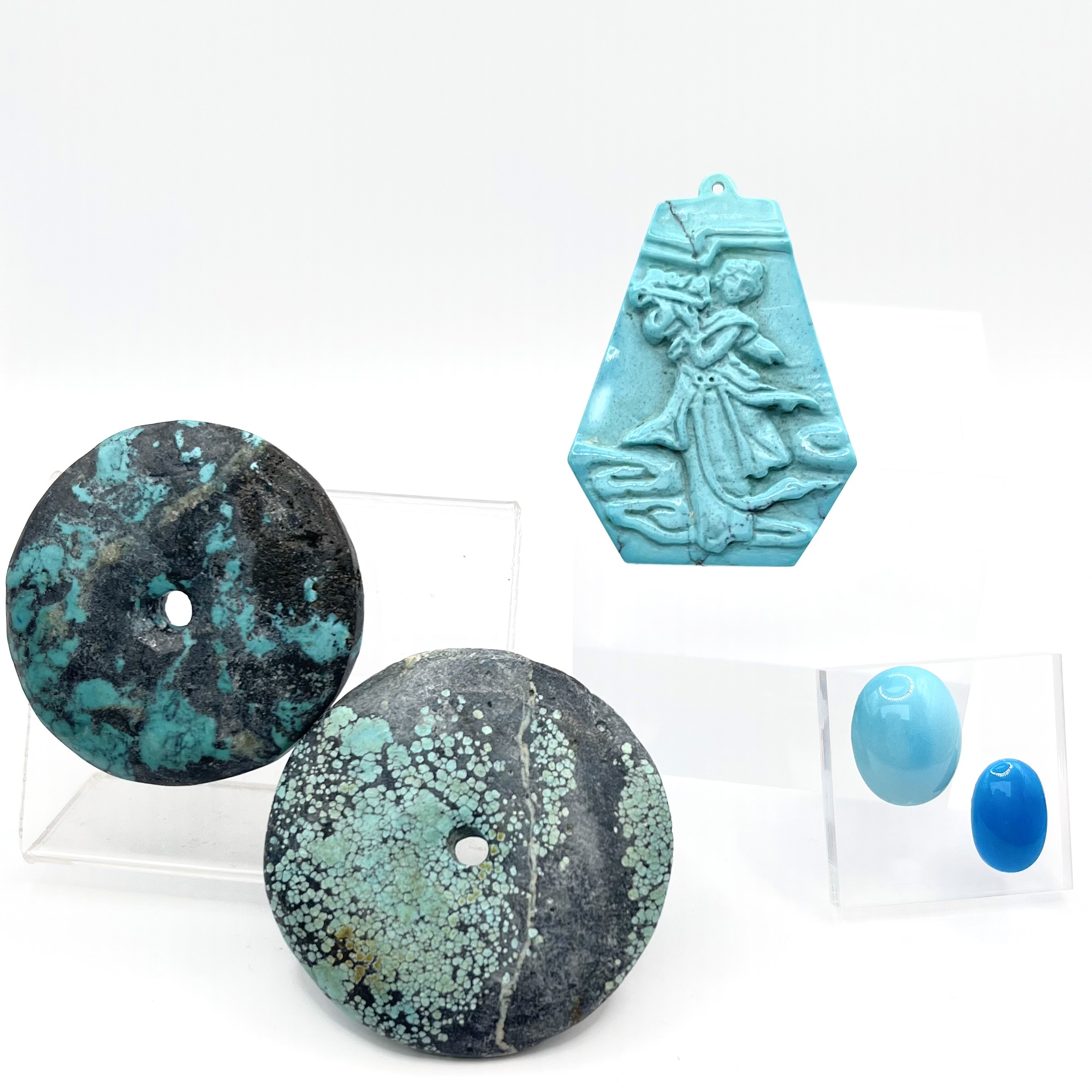 |
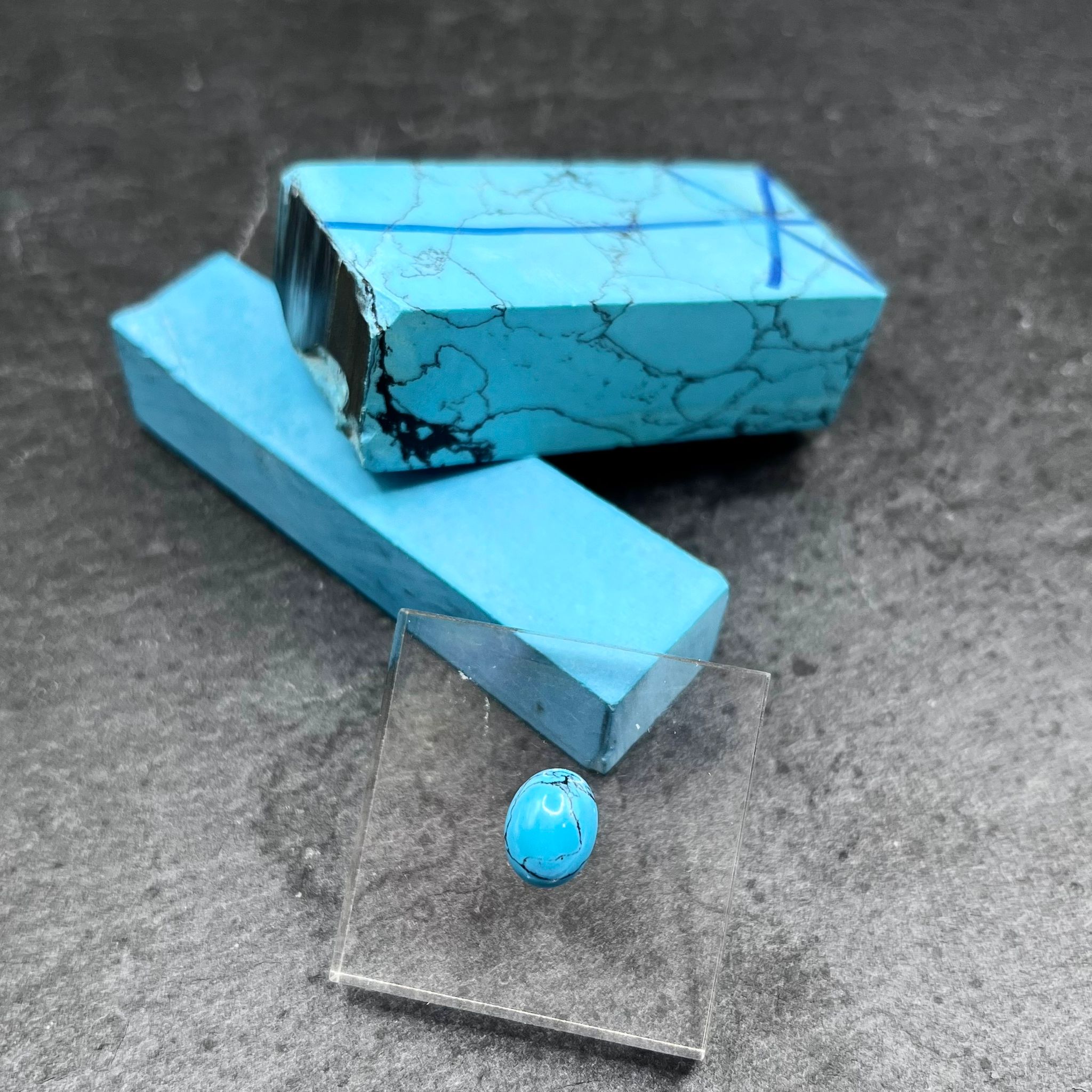 |
| This is a nice piece of polished turquoise from China. Pieces like these are commonly used in carvings | Left: Two round turquoise in matrix. Turquoise deposits usually form in iron-rich limonite or sandstone. Limonite creates dark brown markings in turquoise, while sandstone creates tan markings.
Top: Turquoise carving from China, 56.10ct Right: Lighter blue turquoise from Chile, 9.94ct; More saturated blue turquoise from Iran, 4.65ct.
|
The two blocks in the background are Gilson 'synthetic" turquoise. Similar to the 'synthetic' lapis lazuli, its is made from ceramic, mixed with black matrix to give it a more natural appearance. Front: cabochon cut Gilson 'synthetic' turquoise. |
We have listed out 10 common blue gemstones that you can find in the market. But these are not the only ones available! Here is a list of some interesting blue gemstones that are getting popular among consumers:
| Gem Material | Photo | Description | Localities |
| Blue diamond | 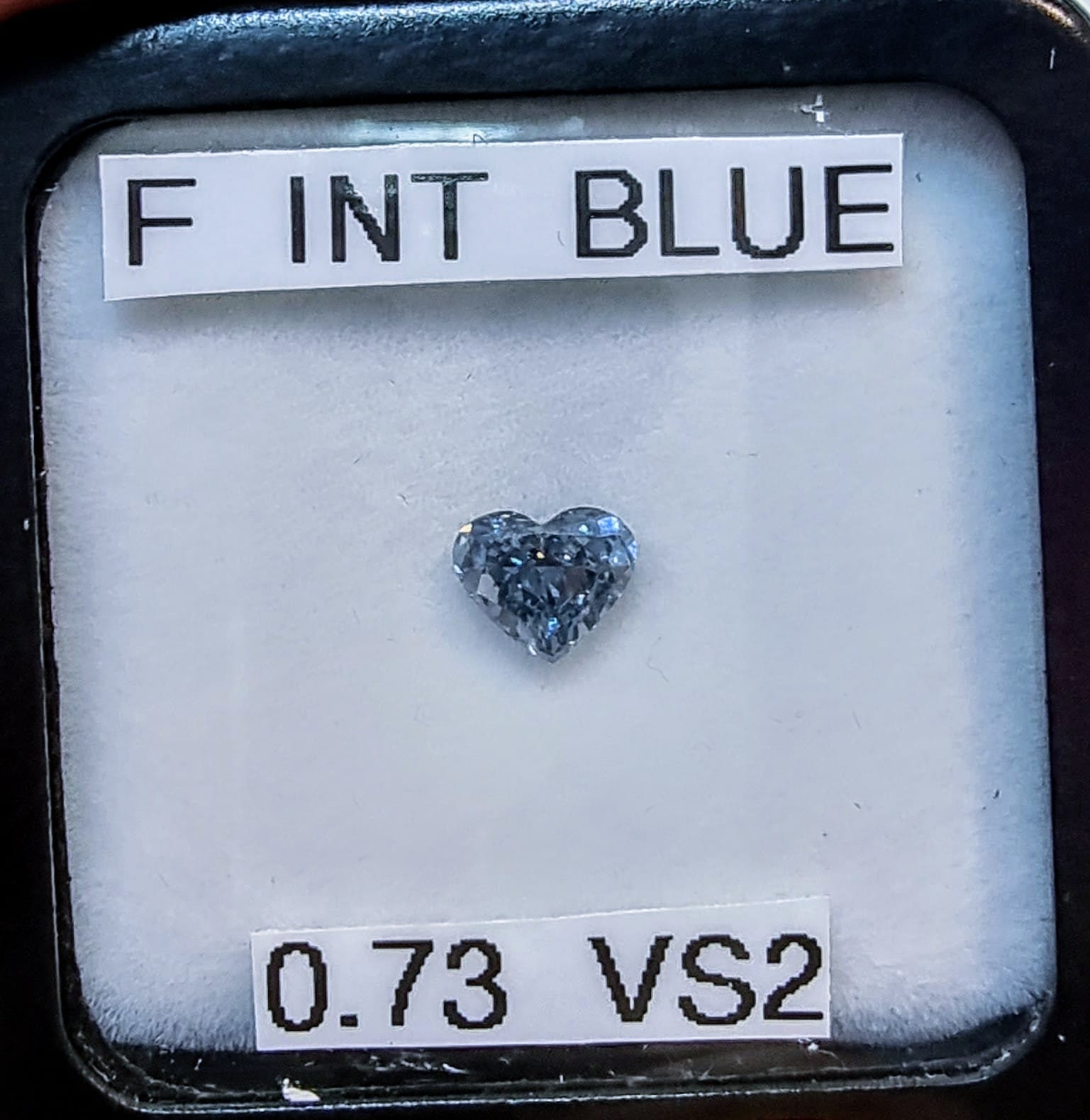 |
The colour of this diamond is described as “fancy intense blue”, which is the top range of blue coloured diamonds (next to a fancy vivid blue). Blue diamonds are coloured by the element boron (B) and tend to have very good clarity. | South Africa, India, Australia, Brazil, Canada, Indonesia. |
| Sodalite | 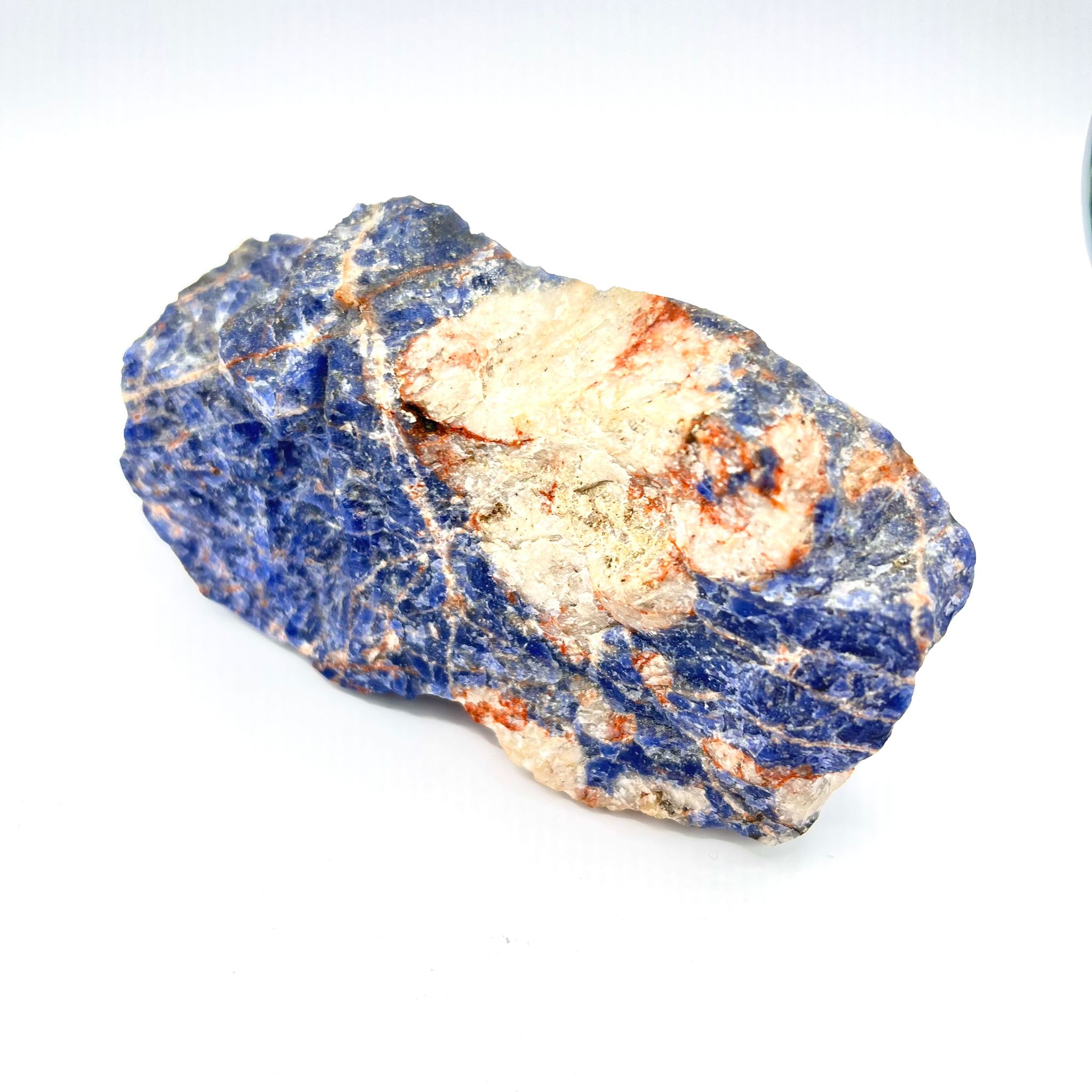 |
This gem is in the cubic crystal system and has a chemical composition of Chloric Sodium Aluminium Silicate. Its name refers to its sodium content. | Bahia (Brazil), Greenland, India, Ontario (Canada), Namibia, Urals (Russia), Montana (USA). |
| Angelite | 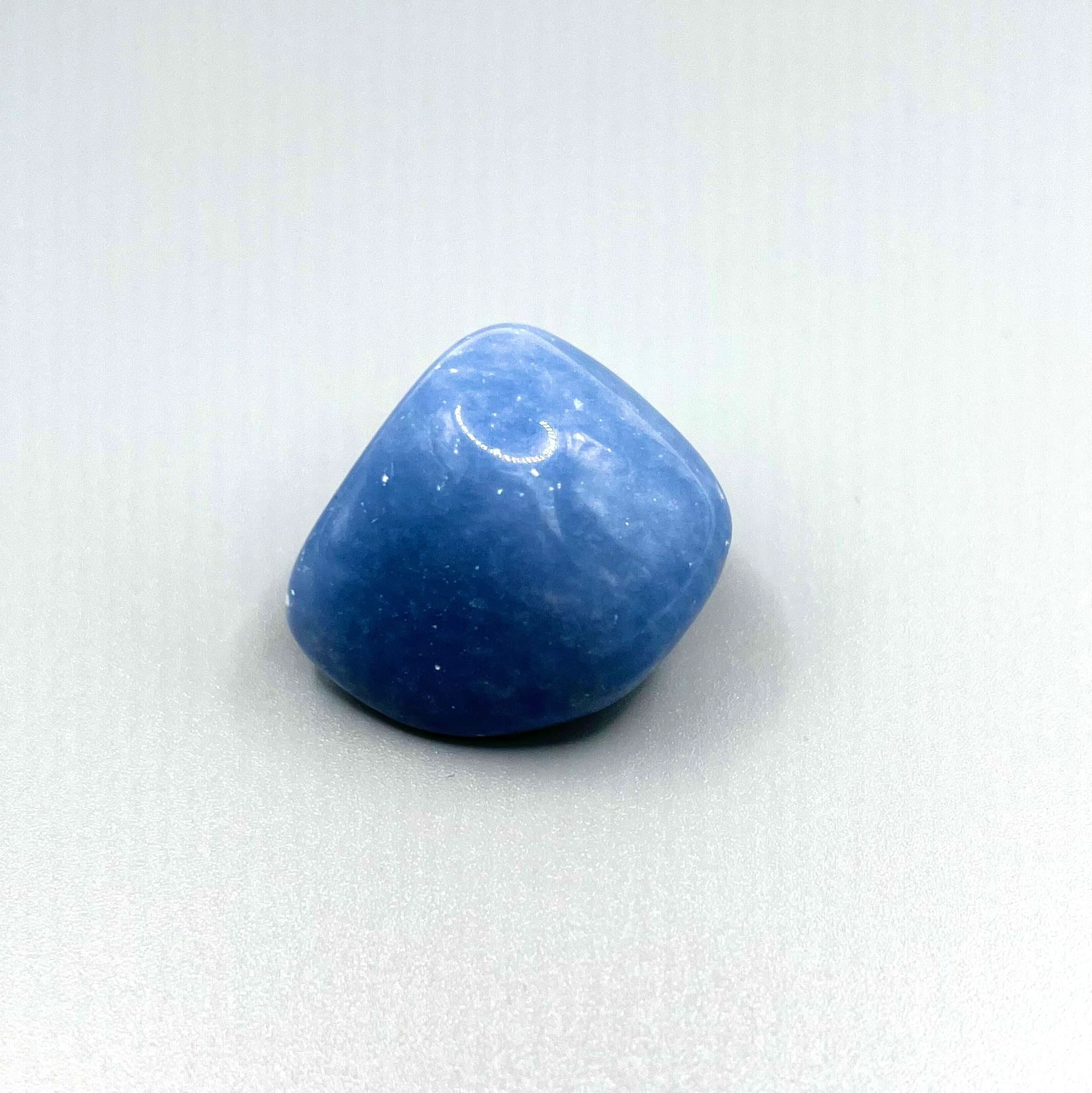 |
Angelite also known as Blue Anhydrite is a mineral first discovered in 1989 by J.I. Koivula and R.C. Kammerling. Anhydrite, which is only found in Peru, is an anhydrous calcium sulfate mineral that can associate itself with Calcites and Halites. | Peru |
| Apatite |  |
Apatite can come in a variety of colours such as pink, yellow, green, blue and violet. It is a brittle material that is in the hexagonal crystal system. Apatite cat’s-eye is commonly known. | Myanmar, Brazil, Mexico, Austria, Sri Lanka, USA, India, Kenya, Madagascar, Norway. |
| Benitoite |  |
Only the small crystals are of gem quality. It maybe confused with all the blue varieties of iolite, kyanite, sapphire, spinel, tanzanite, tourmaline and zircon. | San Benito, County, California (USA) |
| Larimar |  |
This gem is the blue variety of pectolite and have been on the market since the 1970s | Dominican Republic |
| Smithsonite |  |
The chemical composition of this gem is zinc carbonate. It is named after an American mineralogist and may be confused with chrysoprase, hemimorphite and turquoise. | Australia, Greece, Italy, Mexico, Namibia, Spain and New Mexico. |
| Blue Opal |  |
They are called Andean Opals in the trade and belong to the group of common opals. These are opals that do not have play of colour. | Peru |
| Feldspar (with blue sheen) |  |
The varieties in the feldspar group that may show blue sheen as its phenomena optical effects are moonstones and labradorite. The effect is also known as adularescence or labradorescence. | Sri Lanka, Myanmar, Brazil, India, Madagascar, USA, Canada, Australia, Mexico, Russia. |
| Chrysocolla |
|
Where there is an intergrowth of chrysocolla with turquoise and malachite, the stone is known as Eilat Stone, found near Eilat, Israel. Its chemical composition is a hydrous copper silicate. | Chile, Israel, Congo, Mexico, Peru, Russia, Nevada, Zaire, Indonesia, Taiwan. |
| Fluorite |  |
Its chemical composition if calcium fluoride and has perfect cleavage. It has low refractive index and has a hardness of 4. Blue John is the fluorite variety, banded with colours and white, from Derbyshire, England. | Oberpfak, Bavaria (Germany), Argentina, Myanmar, England, France, Namibia, Austria, Switzerland, and Illinois. |
| Iolite |  |
This gem often has inclusions of hematite and geothite, which may cause reddish sheen or aventurescence effect in the stone. It has a misleading trade name “Water Sapphire”, which confuses with corundum | Myanmar, Brazil, India, Madagascar, Sri Lanka, USA. |
| Kyanite | 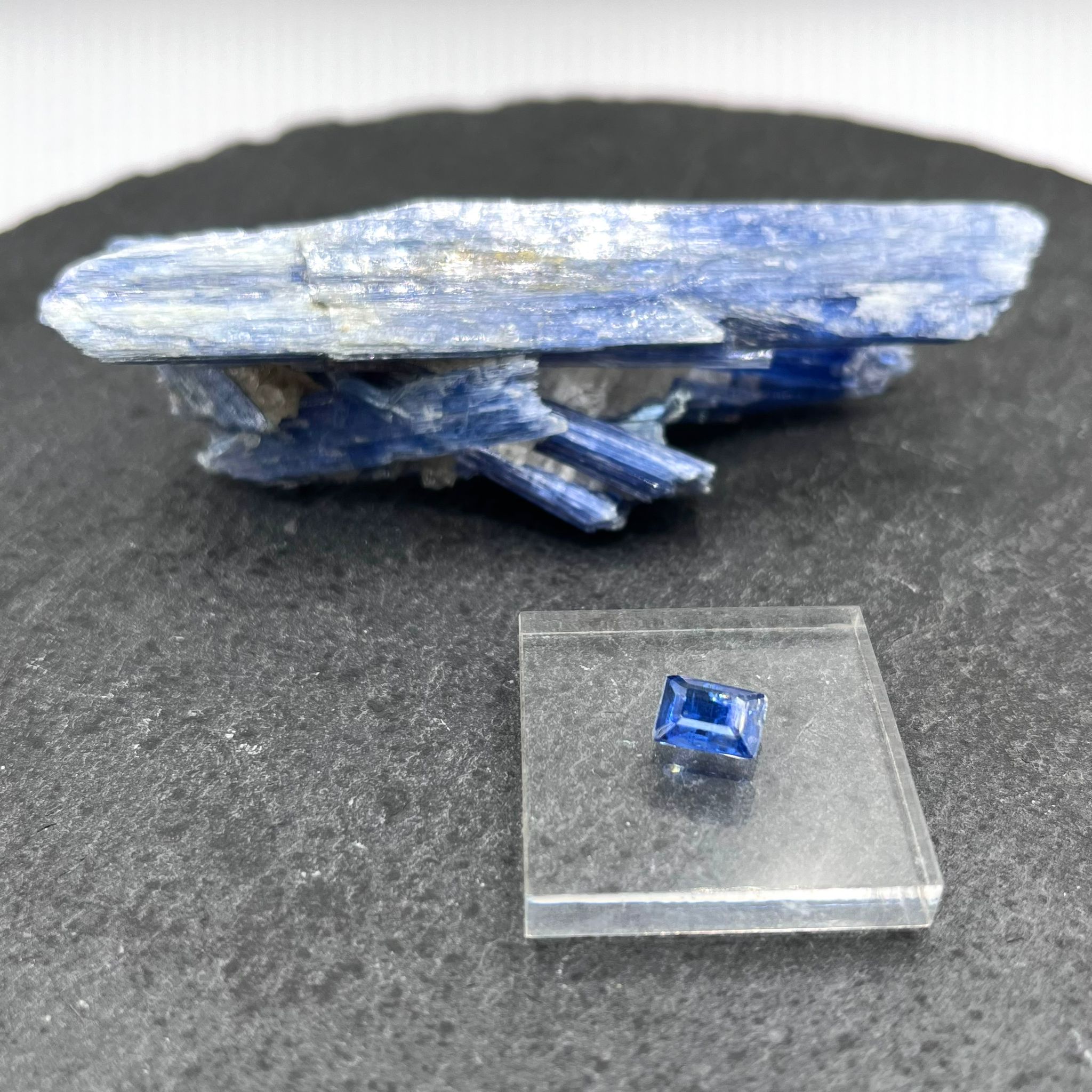 |
This gem material is very difficult to cut due to its directional hardness of 4-4.5 along axes and 6-7 across the crystal. Its chemical composition is aluminium silicate and can occur in various colours such as green, brown and orange. | Myanmar, Brazil, Kenya, Austria, Switzerland, Zimbabwe, USA, Tanzania, Australia. |
References:
https://www.git.or.th/eng/testing_center_en/lab_notes_en/glab_en/2008/heating_experiment_en.html
https://yavorskyy.com/collections/cobalt-blue-spinel
http://www.quartzpage.de/gen_types.html
Anhydrite (Angelite) Value, Price, and Jewelry Information - Gem Society, https://bit.ly/3f4vzc4
Gemstones of the World by Walter Schumann, 4th Edition.
https://www.gia.edu/turquoise-description
Photo Credits:
Far East Gem Institute, Singapore
The King’s Bespoke (a brand under The Gem Capital)


